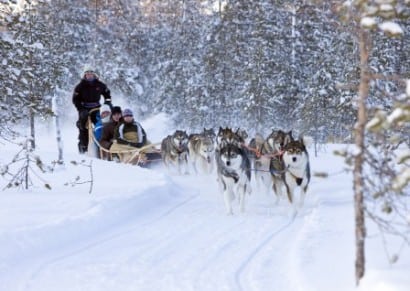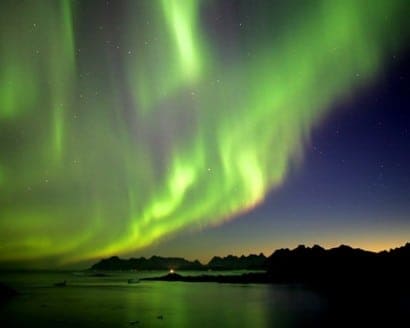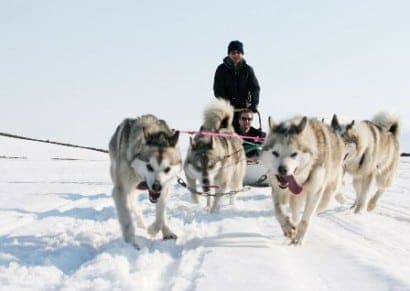SWEDEN is a wonderful destination for dog sledding, and Swedish Lapland, in the far north of the country deep within the Arctic Circle, offers some of the country’s most spectacular scenery and a wide variety of ways to experience the thrill of driving your own dogsled.
From the vast lowland landscape of deep forests, frozen lakes and rivers to the majestic mountain regions; from the magic of a display of the Northern Lights in the night sky to the joy of working closely with your own team of huskies, the reasons to go dog sledding in Swedish Lapland are many and varied!
Giving a Husky hug
For dog lovers with a taste for adventure, dog sledding is an obvious holiday choice. Contrary to many people’s expectations, the dogs are extremely friendly and thrive on human contact and attention. There is nothing a sled dog likes better than a hug at the end of a day on the trail! The dogs typically used for mushing in Swedish Lapland are Siberian Huskies. Their strength, energy and their thick coats make them ideal for dog sledding in a region where typical winter temperatures can be anything from just a few degrees below zero to -30 degrees C or less.
It’s normal to feel a little uncertain at the start, but you will always be given full instruction from your guide in harnessing your team and managing the sled before departure. Even the most hesitant novice musher will normally be surprised how quickly they gain confidence and after a short time you should be justly proud of your new mushing skills and be able to really relax into and enjoy the adventure. The first time you try to harness your dogs you will probably end up in a real tangle, but it’ll soon become second nature.
Man’s best friend
A dogsled tour is a very “hands-on” experience – in addition to driving your own sled, everyone gets involved in the care of the dogs and the various duties around the cabins. A typical day on a multi-day dogsled tour begins with making a fire in the cabin, heating water for the dogs, then going out to feed the dogs and clear their toilet waste. Four dogs to a team and a maximum of six participants per tour (plus guide) makes 28 huskies, so this part can take some time!
Then you have breakfast, pack everything together, clean out the cabin, load the sleds and take to the trail. During the day, you will stop to have lunch outdoors along the way. When you reach your destination for the day, you will put the dogs on a long wire for the night – while you are tucked up in bed, the dogs will be sleeping outside, but don’t worry, their thick fur is ideally suited to withstand the worst of the Arctic winter. In bad weather, it may be necessary dig a wall of snow for the dogs to protect them from the wind and depending on facilities and your accommodation, you may also need to melt water for the dogs to drink. After feeding and seeing to your team, it’s time to relax and enjoy your evening – reflecting on the day’s adventures with your fellow mushers, preparing and cooking dinner together and maybe even taking a sauna to soothe those tired muscles!
The distance covered in a day’s mushing will depend on a number of factors such as snow consistency and the nature of the terrain, but typical distances are around 20-50km.
Land of the endless nights
Winter in Swedish Lapland comes early and stays late, with the season for dog sledding beginning around mid-November and extending until late April. The later part of the winter season in March and April, known as “Spring Winter” by the indigenous Sami people, is the period when conditions become suitable for dog sledding up in the Lapland mountains.
Anytime during the season is a good time to go, and each part of the Arctic winter has its own special atmosphere. The darkest (and usually coldest) period between November and February offers the unique atmosphere of the deep midwinter, with the long hours of darkness giving very good chances to see a display of the magicalAurora. By March, the longer hours of daylight and normally milder temperatures allow you to experience the best of both worlds – the stark beauty of the snow covered mountains and the warming spring sun on your face!
Mush, mush, mush
A dog sledding holiday is suitable for a very wide range of travellers. While people of any age choose to take part, dog sledding can be a challenging activity – you will need to assist your dogsled team at times by jogging or “scooting” behind the sled for short periods, especially on uphill sections or in heavy snow conditions. But, a general good level of fitness, love of the outdoor life and a willingness to work closely with your team is more important than strength.
Mushing is a unique adventure. The friendliness and energy of the dogs, the joy of working closely with your team and getting to know their individual personalities, the beauty of the winter landscape and the excitement and challenge of driving your own sled all might just add up to a tempting combination for your next winter holiday!
Nature Travels, the UK specialists for outdoor experiences in Sweden, offer a wide range of dog sledding tours in Swedish Lapland. For more info, visit Naturetravels.co.uk
Article by Bob Carter for Australian Times
Mushing beneath the Northern Lights



No comments:
Post a Comment